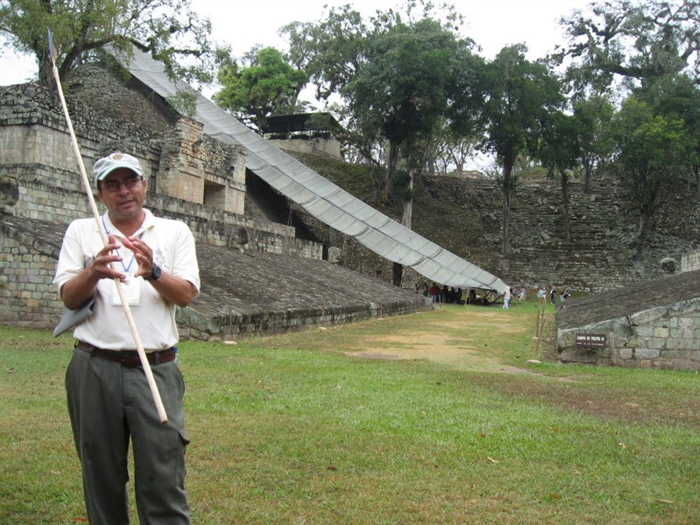博文
Guatemala Trip (I)
||
Fornew readers and those who request to be “好友 good friends” please read my 公告栏 first.
Since I stopped skiing a few years ago due to advancing age, Boston winter has become a bit long and monotonous. Thus, my wife and I began to take winter vacations to warmer spots. Last year we enjoyed the services of the Caravan Tours to Costa Rica http://www.sciencenet.cn/m/user_content.aspx?id=212508
So, we decided to join another one of their Central America tours to Guatemala this winter (2/5-15/2010). As tourism spots, Guatemala is not high on anyone’s list. People’s reaction on being told that you are going to a vacation to Guatemala is often “WHY?” or worse “WHERE?” True. Unlike Machu Picchu in Peru or the Iguaçu Falls in Brazil/Argentina/Uruguay, there are no spectacular but only adequate sceneries. Tourism facilities are acceptable but not outstanding or luxurious. You do not come to Guatemala to view Nature in its entire tropical splendor. Thus, “what for?”. Answer: it is a historical and cultural tour. As the geographical center of the vanished Maya civilization (??? – about 900 AD) and as an independent country since 1821 (the Central America Federation), Guatemala has a sad and tragic history. To put it in terms more easily comprehensible for Chinese ScienceNet readers, imagine China were Guatemala . Then you will have the Mongols conquering China and burned and destroyed much of the extant Chinese civilization- books, religion, and culture at the beginning of the Yuan dynasty (Spaniards did this to the descendents of the Maya people). The Mongols continue to rule until 1821 when you re-gained independence. But for the past 190 years, China has lost Sinjiang, Mongolia, and Manchuria to her powerful neighbors in the North (Mexico annexed a large part of northern Guatemala including the Yucatan peninsula). In the south, Tibet, Hainan, and Taiwan have become independent countries (Honduras, El Salvador, and Belize). On the mainland, there is no effective central government, warlords control much of the territory. Capitalist invasion effectively controlled the country for much of the first half of the 20th century (The US and the United Fruit Corporation). The second half of the 20th century from 1960s-1996 was consumed by a devastating earth quake (1976) and 36 years of continuous civil war and cultural revolution during which million of persons were tortured, killed, and buried in mass graves. Only since the beginning of the 21st century, there is the semblance of a stable government. But corruption is still prevalent.
Most of these facts were news to me until I came to this tour even though I consider myself more or less a well informed citizen. But as an ethnic Chinese, I (and Chinese SceinceNet readers) can appreciate these facts better than most tourists. At a population of 12 million, Guatemala can be thought of as a micro version of China in the last two centuries. The capital, Guatemala City is like Beijing – modern and up to date. But the country side is like a poor village in Gansu. The contrast is stark. For every person that dies, 13 new babies are born due to the high birth rate in rural areas. But the middle class in the city all aspires to two children with both parents working and two cars for each family. There is little social security and most people work till they die. On these basis, China appears to have a better future.
65% of the Guatemala population are indigenous being the descendent of various Maya tribes. 35% are of mixed native and European blood. Only less than 1% are pure Europeans. Main exports are agricultural products (Banana, the term Banana Republic originated here, and coffee) and a emerging tourism industry.
On the brighter tourist side, there are the numerous Maya ruins. The Maya civilization reached its peak in the so-called classic period (~200AD – 900 AD). They had architecture, literature, accurate astronomy, and independently invented the mathematical concept of ZERO and the positional number system (e.g., imagine you have to write out the large number 1,234,567,898,765,432 in Chinese or Roman numerals). But because of inter-tribe warfare, poor farming, and famine, the civilization suffered total collapse after 900 AD and the descendents were reduced to subsistence for some five hundred years until the Spanish conquistadors took over in the 1500s. By then their architectural accomplishment (the ceremonial pyramids and palaces) were either buried or fell into ruins. The Catholic Church burned all their books except for single copy of four books which are now in museums of Dresden, Paris, London and the US. It is from these four books that we eventually decoded the Maya language in the last century. Anyhow, one of the centers of Maya civilization is located in Copan, Honduras just over the border from Guatemala. A succession of 16 Kings developed the place in the classic period and they were all buried in the place. This is very much in the spirit of the Valley of Kings in Egypt.
So far only four of the sixteen king’s tomb have been discovered.. Photos below were taken at the Copan site where we spend one whole day exploring.

Steps of an amphitheater before and after restoration

A typical Maya city plaza and house foundation with explanatory notes

view from a Maya house window

A local guide explaining a Maya ball playing field where the losing team often lose thier head also.
(to be continued)
https://wap.sciencenet.cn/blog-1565-295558.html
上一篇:Will China Achieve Science Supremacy?
下一篇:Guatemala Trip (II)